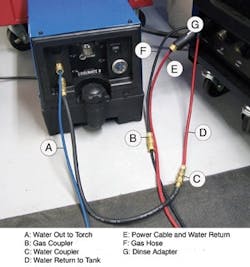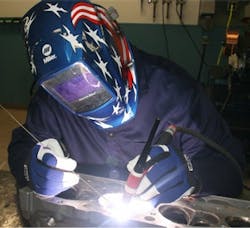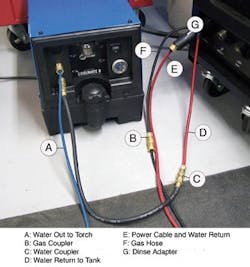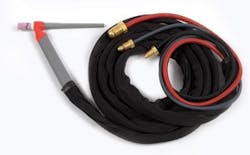In brief:
- TIG torches feature multiple interchangeable parts that must be properly assembled to achieve good welding performance.
- To aid in joint accessibility and increase operator comfort, TIG torches are designed in a variety of shapes and sizes.
- Once you’ve identified the torch components you need, you’re ready to assemble your TIG torch. The steps are the same whether you have an air- or water-cooled model.
Just like any part of the TIG welding process, learning how to assemble and install your TIG torch properly may seem intimidating at first. The torches feature multiple interchangeable parts that must be properly assembled to achieve good welding performance. Plus, both air- and water-cooled models have specific requirements for installation. Nonetheless, educating yourself as to the proper procedures for both types of TIG torches can go a long way in preventing problems and ensuring quality welds.
The torch and its components
To aid in joint accessibility and increase operator comfort, TIG torches are designed in a variety of shapes and sizes. Typically, air-cooled torches are larger and heavier than water-cooled torches. The cooling capacity required for a particular application, as well as the location where you are welding, dictates which one you should use.
[pullquote]For example, if you have a low-amperage application, it’s best to use an air-cooled TIG torch. These torches also work well outside because they don’t require a separate water cooler and are easily portable. Water-cooled torches are recommended for applications requiring more than 200 A and are good for use in the shop.
Before assembling your TIG torch, first consider each of its components. If you have an air-cooled torch, some components may be larger than those built for water-cooled torches. These larger components are necessary due to how these torches dissipate heat. Air-cooled torches rely on ambient air plus argon gas to cool the torch and need the additional surface area of the components to assist in the process. On the other hand, a water-cooled torch has a constant source of coolant removing the heat and therefore has smaller front-end torch parts.
In a TIG torch, the nozzle, also called a cup, directs shielding gas to the weld puddle, while also protecting it and the electrode from outside contaminants. Nozzles range in size from ¼ in. (#4) to 1 in. (#16) and are made primarily of alumina or lava.
The tungsten electrode conducts heat to the arc. The thickness and type of material you are welding, along with whether you weld with alternating or direct current, determines which type of tungsten you should use. A 3/32-in. 2% ceriated tungsten electrode is a common choice, as it can be used for welding at 10 to 250 A. Other tungsten electrode options include pure tungsten, 2% thoriated, 1.5% lanthanated, zirconiated and rare earth.
The size of tungsten you use will determine what size collet and collet body you need (e.g., a 3/32-in. collet matches 3/32-in. tungsten). The collet and collet body are responsible for holding the tungsten electrode in place. If you require greater joint access or better shielding gas coverage, you can replace a collet body with a gas lens. Gas lenses are recommended for welding on highly reactive alloys as the greater gas coverage can prevent contamination. All air- and water-cooled GTAW torches are compatible with gas lenses. Your amperage requirements, tungsten size, and joint configuration will determine the gas lens and corresponding nozzle size you need.
To complete the back end of your TIG torch, you will need to decide between a short, medium, or long back cap, all of which tighten the collet against the collet body to help hold the tungsten in place. The length you choose depends on the joint access you require on your application.
Finally, consider your available hose and power cables: rubber or vinyl. Vinyl works well for light-duty applications; however, braided rubber hoses resist heat and kinking and tend to last longer. Rubber hoses also maintain flexibility and durability in cold environments better than vinyl and are typically standard on air-cooled TIG torches.
Assembly
Once you’ve identified the torch components you need, you’re ready to assemble your TIG torch. The steps are the same whether you have an air- or water-cooled model.
First, assemble the collet and collet body. Then insert the tungsten electrode, making sure you have a tight fit between the collet and electrode. Doing so helps to ensure good conductivity and a stable arc.
Next, insert the back cap into the torch body, but do not tighten it, and insert the tungsten/collet/collet body assembly. Add the nozzle and adjust the electrode to within ¼ inch beyond the end of the nozzle. Hand-tighten the back cap. Tightening the back cap at this stage ensures a secure fit of the tungsten and the collet within the collet body.
If you choose to replace the collet body with a gas lens, you can extend the tungsten electrode farther, up to ½ in. beyond the nozzle, but you will also need to use a larger nozzle. Your local welding distributor or TIG torch manufacturer can help you to determine the correct size to use.
Lastly, be certain that all of the torch component threads and connections are tightened properly. Tight connections prevent problems with electrical conductivity and gas flow that could lead to torch damage or weld discontinuities. Also check all o-rings and gaskets for deterioration or failures that could allow air to be drawn into the shielding gas stream.
Powering up
Before attaching your TIG torch, be certain to turn off your power source.
To install an air-cooled torch, first select the appropriate power cable adapter for your TIG power source and connect it to the torch’s power cable. Consult with your welding distributor for the correct one for your particular power source. Connect the power-cable adapter to the electrode terminal of the power source, making certain the connection is snug. Tight connections prevent overheating and damage to the torch cable.
Figure 1. This diagram shows the proper connection of a water-cooled GTAW torch from the water cooler to the power source.
Next, connect the gas hose to the gas-out connection on the power source and attach a flowmeter regulator to the cylinder; the flowmeter regulator precisely controls the shielding gas flow. Connect the gas hose from the flowmeter regulator to the gas-in connection on the back of the machine, tighten it, and open the gas cylinder valve. Remember, tight connections eliminate shielding gas loss and allow steady flow of the shielding gas to the torch, which in turn promotes good weld quality.
The next step is to connect either the foot pedal or fingertip remote control. The remote control should connect to the remote receptacle on the front of your power source. Using a foot pedal control works well for welding at a bench, while a TIG torch with a fingertip remote control offers greater mobility and eases welding in tight spaces or awkward positions.
You’re now ready to weld — attach your work clamp from the work output terminal of the machine to the work piece and prepare to strike your arc.
Installing a water-cooled TIG torch is similar to installing an air-cooled torch with the addition of a few steps. First, check that the required water cooler has enough coolant, usually about 3 gal. Use only distilled water or an approved welding coolant available through your distributor, or contact the manufacturer of the equipment for information. Never use city water, and never add anti-freeze or any other rust-inhibiting compounds.
Figure 2. Water-cooled torches feature color-coded hoses to ease installation. The output water hose is blue, the return water hose /power cable is red, and the gas hose is black.
When connecting the water-cooled TIG torch to the water-cooling system, it’s important to set up the water flow properly (Figure 1). First, connect the torch’s output water hose (smaller left-hand fitting — blue hose) to the water-out connection on the cooler. Then connect the coolant return/power cable (larger left-handed fitting — red hose) to the power cable adapter and connect that adapter to the output terminal (Figure 2). Next, plug the water cooler into the welding machine receptacle.
As with air-cooled torches, connect the gas hose from the flowmeter regulator to the gas-in receptacle on the back of the machine and connect the gas hose to the gas receptacle on the machine. Connect the foot pedal or remote fingertip control.
Once all of the connections have been made, attach the work clamp to your work piece and turn on the power source. You’re now ready to weld with a water-cooled torch.
Keith Werkley is regional sales manager at Weldcraft. Contact him at [email protected].



